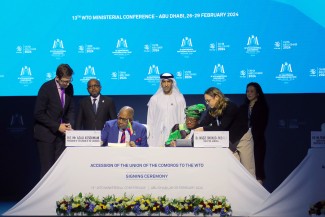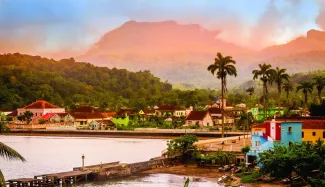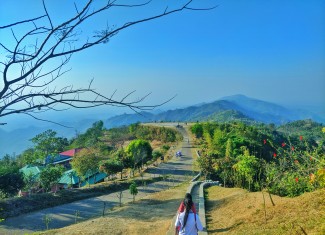Country embarking on a new tourism strategy as part of its building of trade sector
When one thinks about tourism hotspots, Burundi is not the first that comes to mind. But, that doesn’t mean it couldn’t get there.
Nowadays tourism is a fraught topic of course, with the pandemic causing the sector to grind to a halt, and jobs and income for millions across the globe on the line. But for Burundi, tourism contributed only about 3.5% to GDP in 2019, and the sector remains vastly underdeveloped considering its bounteous natural landscapes and rich wildlife.
“There is a poor quality of basic infrastructure, insufficient qualification of professionals in the tourism chain, lack of incentives for investment in the sector, lack of awareness of partners on the benefits of tourism and weak structuring of the sector,” said Leopold Bizindavyi, Monitoring and Evaluation Officer for the Enhanced Integrated Framework (EIF) in Burundi.
He added, “There is a lack of vision to see tourism as a development engine for the future of the country.”
It is with potential in mind that the country is taking the moment to develop a tourism strategy alongside a more general analysis of the country’s trade called a Diagnostic Trade Integration Strategy (DTIS). This research and analysis is produced as part of the country’s categorization as a least developed country (LDC), thus granting it targeted trade assistance from EIF, which is supporting these studies.
“The importance of analysis is fundamental. EIF supports trade research like DTIS and other sector-specific assessments to help inform action and create solutions,” Donelan said.
Post-conflict
Over the past half century or so, Burundi has gained independence from colonization and experienced bouts of ethnic and political conflict. This has left its economy wanting, with 80% of the mostly poor rural population depending on the agriculture sector.
“Before the conflict in 2015 the country was slowly starting to get on its feet and getting more positive GDP growth, as well as a return of tourists. It was transitioning to more of a post-conflict development scenario, and they had got their levels of tourism up to around 300,000 visitors a year,” said Peter Donelan, EIF Coordinator for Burundi.
Since 2015, the land-locked country has been building back, and tourists have slowly been returning.
Donelan said, “The World Bank has tourism as only 1.26% of exports for Burundi. But when you look at this percentage for Rwanda, it's 31%, Tanzania, 26%. So there’s huge scope to expand, and huge potential, also for attracting investment.”
The country’s National Tourism Office has seen business returning to hotels that had been suffering since 2015, as well as an influx of people coming to do business. It has a list of objectives for tourism development to 2027 that includes focusing on business, cultural and sports tourism, and aims to address its hotels, restaurants and tour operators and guides.
Accommodating
“Burundi has comparative advantages. We have a diversity of landscapes. We have Lake Tanganyika where there could be water sports, fishing, scuba diving and cruise tourism where it would be possible to see the shores of the Democratic Republic of Congo, Tanzania and Zambia. Then there’s hiking, historical cultural sites, Karera Falls,” said Bizindavyi.
With the upcoming tourism strategy, it is hoped that additional investments will also flow in for the various needs the country has to attract vacationers and develop sites. But a good plan also requires capacity to implement.
“A lot of effort is needed to sensitize national and international investors. Consequently, it is necessary to have sufficient human, material and financial resources for feasibility studies to identify and protect sites. There are other areas where training is needed,” said Jean Claude Clovis Bahati, who works in planning and management of tourism sites at the National Tourism Office.
The need for resources is crucial for a country like Burundi to spur this kind of development
“The plan is to use this tourism strategy in order to be able to present mini-project proposals to donors to develop infrastructure, for example on Lake Tanganyika. One thinks for example of the World Bank, the European Union, Belgium,” Bizindavyi said.
With the strategy and the DTIS completed, an evidence-backed set of action points will be available, which is useful for donors looking to targeted support.
“We're trying to bring some of the donors on this journey, as donors recognize the importance of tourism for foreign exchange earnings as well as to stimulate investment,” Donelan said.
He noted that an option for the government was to look at building ties and cooperation with neighboring countries with well-established tourism industries like Tanzania and Rwanda. The work with neighbors fits into the regional cooperation that is ongoing as part of the East African Community’s tourism development strategy.
With celebrated sites like the Serengeti, Zanzibar and the Southern Highlands not far away, Burundi is in the right place. Next is finding the right time.
“The objective would be to develop the country's cultural and natural heritage and exploit Burundi's strategic position in the heart of Africa. There are many tourist sites and we have the advantage of being competitively priced,” Bizindavyi said.
Header image: A processing facility in Adama, outside Addis Ababa, Ethiopia. ©Fernando Castro/EIF
If you would like to reuse any material published here, please let us know by sending an email to EIF Communications: eifcommunications@wto.org.



